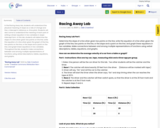
Just in Time Quick Check Direct and Indirect Variation
- Subject:
- Algebra I & II
- Mathematics
- Material Type:
- Assessment
- Provider:
- VDOE
- Author:
- VDOE
- Date Added:
- 10/07/2024

Resources to support Mathematics Standards of Learning for Algebra 1

Just in Time Quick Check Direct and Indirect Variation

Just in Time Quick Check Curve of Best Fit

Just in Time Quick Check Solve Practical Problems with Equations and Systems of Equations

This resource includes an introductory lesson on developing the law of exponents. A student created python coded program is used to develop the laws and there is also a two truths and a lie activity for application of the laws.

Use linear inequalities in one variable to solve practical problemsMathematics Instructional Plans (MIPs) help teachers align instruction with the Mathematics Standards of Learning (SOL) by providing examples of how the knowledge, skills and processes found in the SOL and curriculum framework can be presented to students in the classroom.

Activities that help students explore writing a linear equation.

Solving literal equations for a specified variable Mathematics Instructional Plans (MIPs) help teachers align instruction with the Mathematics Standards of Learning (SOL) by providing examples of how the knowledge, skills and processes found in the SOL and curriculum framework can be presented to students in the classroom.

Students will find helpful resources for learning and practicing math skills and processes in this eMediaVA collection.

This collection has resources organized by grade level teachers can use to teach math.

Multiplying polynomialsMathematics Instructional Plans (MIPs) help teachers align instruction with the Mathematics Standards of Learning (SOL) by providing examples of how the knowledge, skills and processes found in the SOL and curriculum framework can be presented to students in the classroom.

A.2b Multiplying Polynomials Using Algebra Tiles Co-Teaching MIP

In this Desmos activity, students will practice multiplying polynomials with Algebra Tiles. Students should have prior knowledge of the area model of multiplication before utilizing this resource.

Operations with expressions written in scientific notationMathematics Instructional Plans (MIPs) help teachers align instruction with the Mathematics Standards of Learning (SOL) by providing examples of how the knowledge, skills and processes found in the SOL and curriculum framework can be presented to students in the classroom.

Speed Dating review activity for practicing operations with polynomials in Algebra I.

This is a hands on lesson to get students up and moving while also learning about calculating quadratic regressions. It incorporates techology such as DESMOS and/or CODAP to get students comfortable with these programs and loooking at data in different ways.

Solving multistep linear equations.Mathematics Instructional Plans (MIPs) help teachers align instruction with the Mathematics Standards of Learning (SOL) by providing examples of how the knowledge, skills and processes found in the SOL and curriculum framework can be presented to students in the classroom.

Relating the roots (zeros) of a quadratic equation and the graph of the equationMathematics Instructional Plans (MIPs) help teachers align instruction with the Mathematics Standards of Learning (SOL) by providing examples of how the knowledge, skills and processes found in the SOL and curriculum framework can be presented to students in the classroom.

Students observe patterns between the graph, x-intercepts, factored form, roots, equation, and zeros. They use the patterns they observed and the information given in one column to fill in the other columns.

Students work collaboratively or independently to sort and match sets of quadratic equations to the factored form and to the graph/roots.

In the Racing Away lab, students will understand the physical meaning of slope as a rate of change and the y-intercept in distance vs. time plots. Students will also come to understand the meaning of each part of writing a linear equation in two variables in slope-intercept form.
In this lab, students will determine the slope of a line when given two points on the line; write the equation of a line when given the graph of the line, two points on the line, or the slope and a point on the line; and graph linear equations in two variables. Throughout the lab, students make connections between and among multiple representations of functions using verbal descriptions, tables, equations, and graphs.